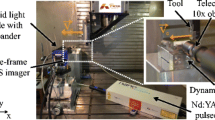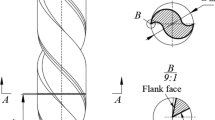Abstract
In precision machining, the milling tool’ geometry has a great influence on the milled surface quality. The research on milling tool state monitoring was mainly based on one-dimensional signals and two-dimensional images, which could indirectly obtain the tool state and wear area, but it could not provide the volume of milling tool wear and breakage area, thereby making it difficult to achieve quantitative analysis tool wear. This paper proposed a three-dimensional (3D) reconstruction method of the milling tool tip, it could build a 3D model of the milling tool tip, and then the volume of the wear and breakage region of the milling tool tip was extracted by the 3D model. Firstly, the focusing degree of image sequence’s pixels was calculated based on the non-subsampled discrete shearlet transform (NSST) and Laplace algorithm, and the 3D reconstruction of the milling tool tip was completed according to the shape-from-focus (SFF) principle; secondly, the depth values were optimized by fitting the focusing degree curve of pixels in the image sequence with Gaussian function; finally, the volume of the 3D point cloud of the milling tool tip was calculated by the Simpson double numerical integration method, and the material loss in the damaged region could be obtained. In the 3D reconstruction experiment of the milling tool tip, comparing the different focus degree evaluation operators of SFF, the proposed 3D reconstruction method has the least noise and the best performance in the root-mean-square error, correlation, and smoothness indexes.
















Similar content being viewed by others
Data availability
The datasets used or analyzed during the currentstudy are available from the corresponding author on reasonable request.
References
Fernández-Robles L, Sánchez-González L, Díez-González J, Castejón-Limas M, Pérez H (2021) Use of image processing to monitor tool wear in micro milling. Neurocomputing 452:333–340
Dai Y, Zhu K (2018) A machine vision system for micro-milling tool condition monitoring. Precis Eng 52:183–191
Huang Z, Zhu J, Lei J, Li X, Tian F (2021) Tool wear monitoring with vibration signals based on short-time fourier transform and deep convolutional neural network in milling. Math Probl Eng 2021:1–14
Guo J, Wang XY, Zhao Y, Hou CY, Zhu X (2022) On-machine measurement of tool nose radius and wear during precision/ultra-precision machining. Adv Manuf 10(3):368–381
Tian Y, Yang L (2022) Multi-dimension tool wear state assessment criterion on the spiral edge of the milling cutter. Int J Adv Manuf Technol 119(11-12):8243–8256
Shi T, Qi Y, Zhu C, Tang Y, Wu B (2021) Three-dimensional microscopic image reconstruction based on structured light illumination. Sensors 21(18):6097
Shah SM, Crawshaw JP, Boek ES (2017) Three-dimensional imaging of porous media using confocal laser scanning microscopy. J Microsc 265(2):261–271
Yan T, Wu P, Qian Y, Hu Z, Liu F (2020) Multiscale fusion and aggregation PCNN for 3D shape recovery. Inf Sci 536:277–297
Hou J, Ouyang W, Xu B, Wang R (2020) Convolutional neural network for extracting 3D point clouds of fibrous web from multi-focus images. IEEE Access 8:87857–87869
Zhu A, He D, Zhao J, Luo W, Chen W (2017) 3D wear area reconstruction of grinding wheel by frequency-domain fusion. Int J Adv Manuf Technol 88(1):1111–1117
He Y, Deng N, Xin B, Liu L (2021) 3D microstructure reconstruction of nonwoven fabrics based on depth from focus. Micron 144:103035
Salokhiddinov S, Lee S (2020) Iterative Refinement of Uniformly Focused Image Set for Accurate Depth from Focus. Appl Sci 10(23):8522
Lee I, Mahmood MT, Choi TS (2013) Adaptive window selection for 3D shape recovery from image focus. Opt Laser Technol 45:21–31
Mahmood MT, Lee IH (2020) Shape from focus based on 3D structure tensor using optical microscopy. Microsc Res Tech 83(1):48–55
Lee IH, Shim SO, Choi TS (2013) Improving focus measurement via variable window shape on surface radiance distribution for 3D shape reconstruction. Opt Lasers Eng 51(5):520–526
Martišek D (2018) Fast Shape-From-Focus method for 3D object reconstruction. Optik 169:16–26
Mahmood MT, Khan A, Choi TS (2008) A Transformed Domain based Novel Focus Measure for 3D Shape Recovery. IEEE/ASME International Conference on Mechtronic and Embedded Systems and Applications, IEEE, 2008: 53-58
Shim SO (2022) Multidirectional focus measure for accurate three-dimensional shape recovery of microscopic objects. Microsc Res Tech 85(3):940–947
Tseng CY, Wang SJ (2014) Shape-from-focus depth reconstruction with a spatial consistency model. IEEE Trans Circuits Syst Video Technol 24(12):2063–2076
Kim GB, Tian GY (2009) A novel depth-from-focus-based measurement system for the reconstruction of surface morphology with depth discontinuity. Int J Adv Manuf Technol 40(11):1158–1165
Chang WC, Wu CH, Tsai YH, Chiu, WY (2017) Object volume estimation based on 3d point cloud. International Automatic Control Conference (CACS). IEEE, 2017: 1-5
Wu H, Yang N, Chen H, Liang W, Ahmad B (2021) Volume Calculation for Power Equipment Point Cloud Based on Concave Hull Slice Method. International Conference on Power and Renewable Energy (ICPRE). IEEE, 2021: 302-306
Lin W, Meng Y, Qiu Z, Zhang S, Wu J (2017) Measurement and calculation of crown projection area and crown volume of individual trees based on 3D laser-scanned point-cloud data. Int J Remote Sens 38(4):1083–1100
Zhi Y, Zhang Y, Chen H, Yang K, Xia H (2016) A method of 3d point cloud volume calculation based on slice method. International Conference on Intelligent Control and Computer Application (ICCA 2016). Atlantis Press, pp 155–158
Mendapara P (2010) Depth map estimation using multi-focus imaging. University of Windsor, pp 2–3
Labate D, Lim WQ, Kutyniok G, Weiss G (2005) Sparse multidimensional representation using shearlets. The International Society for Optical Engineering, SPIE, 5914: 254-262
Guo K, Labate D (2007) Optimally sparse multidimensional representation using shearlets. SIAM J Math Anal 39(1):298–318
Easley G, Labate D, Lim WQ (2008) Sparse directional image representations using the discrete shearlet transform. Appl Comput Harmon Anal 25(1):25–46
Nayar SK, Nakagawa Y (1994) Shape from focus. IEEE Trans Pattern Anal Mach Intell 16(8):824–831
Huang W, Jing Z (2007) Evaluation of focus measures in multi-focus image fusion. Pattern Recognit Lett 28(4):493–500
Yu L, Wang G, Zhi C, Xu B (2019) 3D web reconstruction of a fibrous filter using sequential multi-focus images. Comput Model Eng Sci 119(2):365–372
Zhang L, Liu P, Liu Y, Yu F (2010) High quality multi-focus polychromatic composite image fusion algorithm based on filtering in frequency domain and synthesis in space domain. J Zhejiang Univ Sci C 11:365–374
Pertuz S, Puig D, Garcia MA (2013) Analysis of focus measure operators for shape-from-focus. Pattern Recognit 46(5):1415–1432
Yan T, Hu Z, Qian Y, Qiao Z, Zhang L (2020) 3D shape reconstruction from multifocus image fusion using a multidirectional modified Laplacian operator. Pattern Recognit 98:107065
Ahmad MB, Choi TS (2005) A heuristic approach for finding best focused shape. IEEE Trans Circuits Syst Video Technol 15(4):566–574
Malik AS, Choi TS (2007) Application of passive techniques for three dimensional cameras. IEEE Trans Consum Electron 53(2):258–264
Yun J, Choi TS (1999) Accurate 3-D shape recovery using curved window focus measure. Proceedings 1999 International Conference on Image Processing (Cat. 99CH36348). IEEE, 3: 910-914
Acknowledgements
This work was funded by Special Projects in Key Fields of General Universities in Guangdong Province (No. 2022ZDZX3070) and the Science and Technology Planning Project of Shenzhen Municipality, China (Grant No. JCYJ20190808113413430). The authors are also grateful to the colleagues for their essential contribution to the work.
Funding
The work is financially supported by Special Projects in Key Fields of General Universities in Guangdong Province (No. 2022ZDZX3070) and the Science and Technology Planning Project of Shenzhen Municipality, China (Grant No. JCYJ20190808113413430).
Author information
Authors and Affiliations
Contributions
All authors participated in the work of the paper. Yeping Peng: writing—review and editing, methodology; Shucong Qin: writing—original draft, methodology, data curation resource; Tao Wang: project administration, conceptualization, funding acquisition; Yixi Hu: investigation; Shiping Nie: material preparation. All authors read and approved the final manuscript.
Corresponding author
Ethics declarations
Conflict of interest
The authors declare no competing interests.
Additional information
Publisher’s note
Springer Nature remains neutral with regard to jurisdictional claims in published maps and institutional affiliations.
Rights and permissions
Springer Nature or its licensor (e.g. a society or other partner) holds exclusive rights to this article under a publishing agreement with the author(s) or other rightsholder(s); author self-archiving of the accepted manuscript version of this article is solely governed by the terms of such publishing agreement and applicable law.
About this article
Cite this article
Peng, Y., Qin, S., Wang, T. et al. Volume monitoring of the milling tool tip wear and breakage based on multi-focus image three-dimensional reconstruction. Int J Adv Manuf Technol 126, 3383–3400 (2023). https://doi.org/10.1007/s00170-023-11335-y
Received:
Accepted:
Published:
Issue Date:
DOI: https://doi.org/10.1007/s00170-023-11335-y




